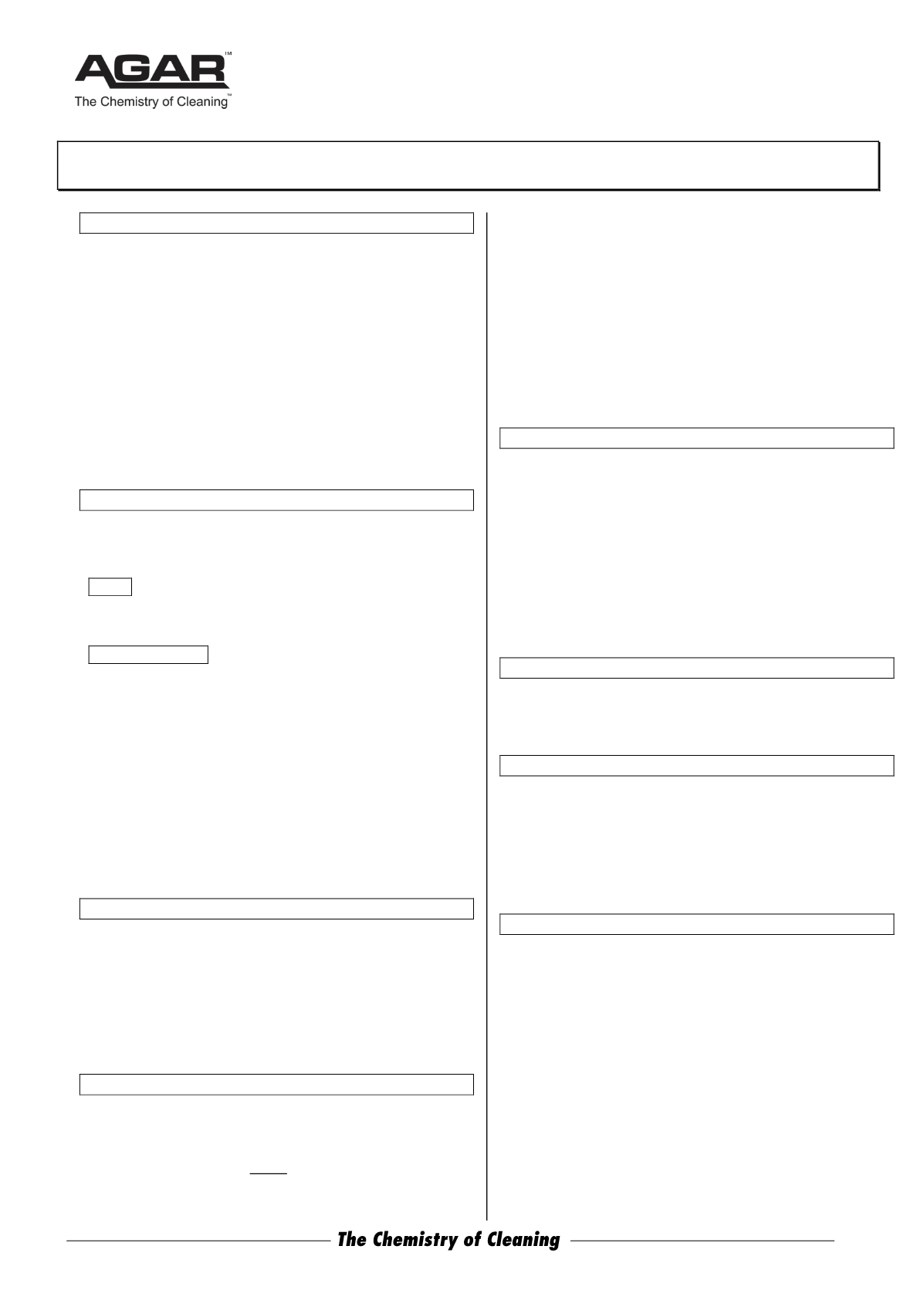

ABN 80 004 726 890 | MADE IN AUSTRALIA
VIC 03 9480 3000
NSW 02 9743 6020
SA 08 8293 2020
QLD 07 3274 3438
WA 08 9249 4566
Safety Data Sheet
Issued: March 26, 2014
Page 1 of 2
GALLEY 2
1 IDENTIFICATION OF THE MATERIAL AND SUPPLIER
Product Name:
GALLEY 2 DISHWASH POWDER
Other Names: None
Manufacturer's Product Code: GAL5, GAL10
Product Use: Machine dishwash powder detergent.
COMPANY DETAILS
Company: Agar Cleaning Systems Pty. Ltd.
Address: 12-14 Cope Street, Preston, Vic. 3072
Telephone: 03 9480 3000 Facsimile: 03 9480 5100
Web:
www.agar.com.auAgar SDS are available from this website.
E-mail:
sales@agar.com.auEmergency Telephone Number: 131 126
(Aust wide)
2 HAZARDS IDENTIFICATION
Hazardous according to criteria of Worksafe Australia.
Corrosive C. Not classed as Dangerous Goods.
Risks: Causes burns. [R34]
Irritating to respiratory system. [R37]
Safety Directions:
Keep out of the reach of children. [S2]
Keep away from food, drink and animal food stuffs.[S13]
Avoid contact with skin and eyes. [S24/25]
Wear suitable protective clothing, gloves and
eye/face protection. [S36/37/39]
In case of accident or if you feel unwell, seek
medical advice immediately (show the label
whenever possible). [S45]
3 COMPOSITION / INFORMATION ON INGREDIENTS
Ingredients:
Chemical Entity:
CAS No.:
Proportion:
Disodium metasilicate
6834-92-0
10 - < 30%
Surfactants
non-haz
< 10 %
Alkaline sodium salts
> 60 %
Chlorine compound
2893-78-9
< 10 %
Sodium nitrite
7632-00-0
< 1 %
4 FIRST AID MEASURES
Poisons Information Centre: Phone 131 126
Swallowed:
If poisoning occurs, contact a doctor or Poisons
Information Centre. Seek urgent medical assistance. If
swallowed, do NOT induce vomiting. Give a glass of water.
Rinse mouth with water. Never give anything by mouth to an
unconscious person.
Eye:
Immediately hold the eyes open and wash continuously for
at least 15 minutes with fresh running water. Ensure irrigation
under eyelids by occasionally lifting the upper and lower lids.
Contact a doctor or Poisons Information Centre (see
telephone numbers above). Removal of contact lenses after
an eye injury should only be undertaken by skilled personnel.
Skin:
Remove any contaminated clothing and flush area with
water. Seek medical attention in the event of irritation.
Inhaled:
Blow nose, clean nostrils with moist cotton wool. If any
effects are observed, remove affected person to fresh air. Lay
patient down. Keep warm and rested. If breathing is shallow or
has stopped, ensure clear airway and apply resuscitation. Call
a doctor.
5 FIRE FIGHTING MEASURES
Fire/Explosion Hazard: Galley 2 is not combustible. Admixture
with water or acids may produce chlorine fumes.
Fire Extinguishing Media: Water spray or fog. Foam. Dry
chemical powder. Carbon dioxide.
Fire Fighter’s PPE: Wear self-contained breathing apparatus
with full face piece and protective clothing.
Special Fire-Fighting Procedures: Quench with massive
quantities of water to extinguish thermal decomposing
products. Wear PPE.
Unusual Fire Hazards: None.
Hazardous products of combustion: Thermal decomposition in a
large fire may yield toxic fumes including chlorine.
6 ACCIDENTAL RELEASE MEASURES
Clean up all spills immediately. Avoid contact with skin and
eyes. Contain spill and scoop up. Place in a suitable, labelled
container for waste disposal.
7 HANDLING AND STORAGE
Storage and Transport: Store in a cool, dry place. Store away
from acids. Keep containers closed at all times. Keep out of
reach of children.
Incompatibility (Materials to avoid for purposes of transport,
handling and storage only): Avoid storage with acids. Keep
containers dry.
8 EXPOSURE CONTROLS / PERSONAL PROTECTION
Exposure Standards: None assigned for mixture. Data for
principal ingredients only:
Atmospheric Contaminant Exposure Standard for:
Chlorine CAS No. 7782-50-5 TWA = 1 ppm or 3 mg/cu.m
(n.b. these Standards are for airborne substances).
[Source: Safe Work Australia HSIS- 2014]
Engineering Controls: Mechanical Ventilation: Not required.
Personal Protection:
Gloves - Wear natural rubber gloves when using this product.
Eye-protection - Suitable eye/face protection should be worn.
Respiratory – If dust is present in the air, wear a OSHA-
NIOSH approved respirator.
Please turn to page 2.


















